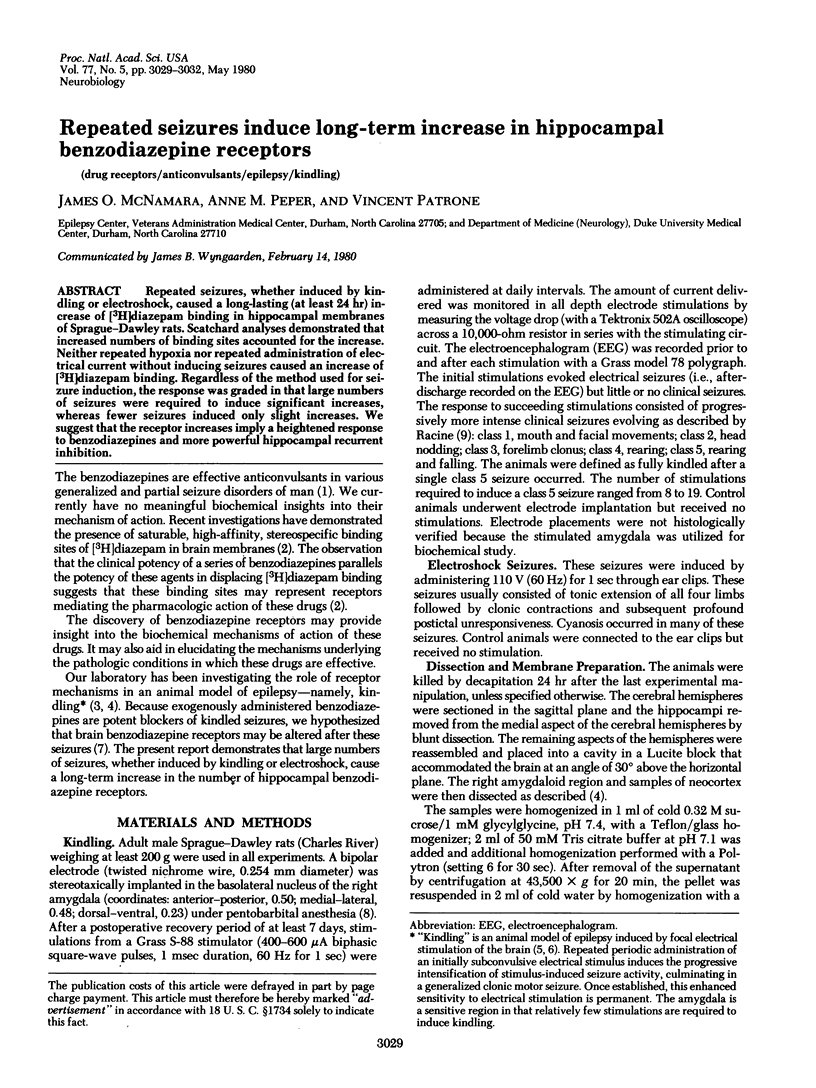Abstract
Repeated seizures, whether induced by kindling or electroshock, caused a long-lasting (at least 24 hr) increase of [3H]diazepam binding in hippocampal membranes of Sprague-Dawley rats. Scatchard analyses demonstrated that increased numbers of binding sites accounted for the increase. Neither repeated hypoxia nor repeated administration of electrical current without inducing seizures caused an increase of [3H]diazepam binding. Regardless of the method used for seizure induction, the response was graded in that large numbers of seizures were required to induce significant increases, whereas fewer seizures induced only slight increases. We suggest that the receptor increases imply a heightened response to benzodiazepines and more powerful hippocampal recurrent inhibition.
Full text
PDF



Selected References
These references are in PubMed. This may not be the complete list of references from this article.
- Asano T., Spector S. Identification of inosine and hypoxanthine as endogenous ligands for the brain benzodiazepine-binding sites. Proc Natl Acad Sci U S A. 1979 Feb;76(2):977–981. doi: 10.1073/pnas.76.2.977. [DOI] [PMC free article] [PubMed] [Google Scholar]
- Babington R. G., Wedeking P. W. The pharmacology of seizures induced by sensitization with low intensity brain stimulation. Pharmacol Biochem Behav. 1973 Jul-Aug;1(4):461–467. doi: 10.1016/0091-3057(73)90013-0. [DOI] [PubMed] [Google Scholar]
- Browne T. R. Clonazepam. N Engl J Med. 1978 Oct 12;299(15):812–816. doi: 10.1056/NEJM197810122991505. [DOI] [PubMed] [Google Scholar]
- Choi D. W., Farb D. H., Fischbach G. D. Chlordiazepoxide selectively augments GABA action in spinal cord cell cultures. Nature. 1977 Sep 22;269(5626):342–344. doi: 10.1038/269342a0. [DOI] [PubMed] [Google Scholar]
- Curtis D. R., Duggan A. W., Felix D., Johnston G. A. GABA, bicuculline and central inhibition. Nature. 1970 Jun 27;226(5252):1222–1224. doi: 10.1038/2261222a0. [DOI] [PubMed] [Google Scholar]
- Goddard G. V., McIntyre D. C., Leech C. K. A permanent change in brain function resulting from daily electrical stimulation. Exp Neurol. 1969 Nov;25(3):295–330. doi: 10.1016/0014-4886(69)90128-9. [DOI] [PubMed] [Google Scholar]
- Kebabian J. W., Zatz M., Romero J. A., Axelrod J. Rapid changes in rat pineal beta-adrenergic receptor: alterations in l-(3H)alprenolol binding and adenylate cyclase. Proc Natl Acad Sci U S A. 1975 Sep;72(9):3735–3739. doi: 10.1073/pnas.72.9.3735. [DOI] [PMC free article] [PubMed] [Google Scholar]
- LOWRY O. H., ROSEBROUGH N. J., FARR A. L., RANDALL R. J. Protein measurement with the Folin phenol reagent. J Biol Chem. 1951 Nov;193(1):265–275. [PubMed] [Google Scholar]
- Macdonald R., Barker J. L. Benzodiazepines specifically modulate GABA-mediated postsynaptic inhibition in cultured mammalian neurones. Nature. 1978 Feb 9;271(5645):563–564. doi: 10.1038/271563a0. [DOI] [PubMed] [Google Scholar]
- McNamara J. O. Muscarinic cholinergic receptors participate in the kindling model of epilepsy. Brain Res. 1978 Oct 13;154(2):415–420. doi: 10.1016/0006-8993(78)90716-3. [DOI] [PubMed] [Google Scholar]
- McNamara J. O. Selective alterations of regional beta-adrenergic receptor binding in the kindling model of epilepsy. Exp Neurol. 1978 Sep 15;61(3):582–591. doi: 10.1016/0014-4886(78)90025-0. [DOI] [PubMed] [Google Scholar]
- Paul S. M., Skolnick P. Rapid changes in brain benzodiazepine receptors after experimental seizures. Science. 1978 Nov 24;202(4370):892–894. doi: 10.1126/science.715447. [DOI] [PubMed] [Google Scholar]
- Racine R. J. Modification of seizure activity by electrical stimulation. II. Motor seizure. Electroencephalogr Clin Neurophysiol. 1972 Mar;32(3):281–294. doi: 10.1016/0013-4694(72)90177-0. [DOI] [PubMed] [Google Scholar]
- Ramer D., Pinel J. P. Progressive intensification of motor seizures produced by periodic electroconvulsive shock. Exp Neurol. 1976 May;51(2):421–433. doi: 10.1016/0014-4886(76)90266-1. [DOI] [PubMed] [Google Scholar]
- Sporn J. R., Harden T. K., Wolfe B. B., Molinoff P. B. beta-Adrenergic receptor involvement in 6-hydroxydopamine-induced supersensitivity in rat cerebral cortex. Science. 1976 Nov 5;194(4265):624–626. doi: 10.1126/science.10626. [DOI] [PubMed] [Google Scholar]
- Squires R. F., Brastrup C. Benzodiazepine receptors in rat brain. Nature. 1977 Apr 21;266(5604):732–734. doi: 10.1038/266732a0. [DOI] [PubMed] [Google Scholar]
- Toffano G., Guidotti A., Costa E. Purification of an endogenous protein inhibitor of the high affinity binding of gamma-aminobutyric acid to synaptic membranes of rat brain. Proc Natl Acad Sci U S A. 1978 Aug;75(8):4024–4028. doi: 10.1073/pnas.75.8.4024. [DOI] [PMC free article] [PubMed] [Google Scholar]
- Tsuchiya T., Fukushima H. Effects of benzodiazepines and pentobarbitone on the gaba-ergic recurrent inhibition of hippocampal neurons. Eur J Pharmacol. 1978 Apr 15;48(4):421–424. doi: 10.1016/0014-2999(78)90169-3. [DOI] [PubMed] [Google Scholar]


